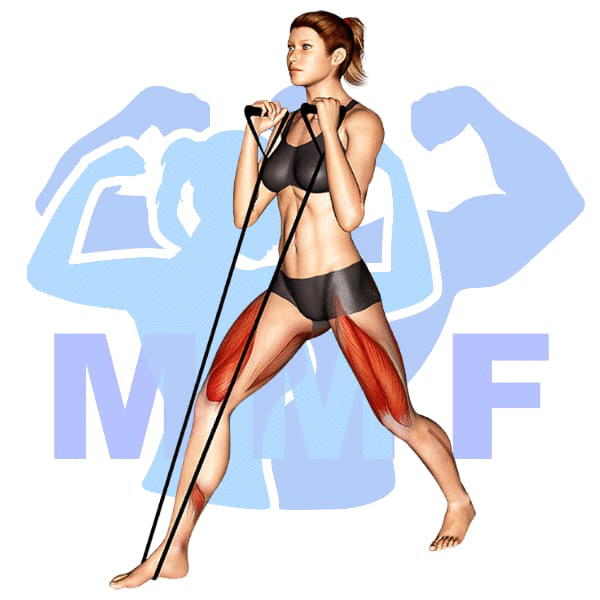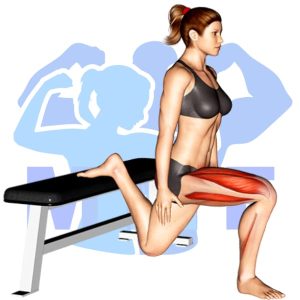Are you tired of feeling like lunges are too difficult or painful to do? And are you using resistance bands to help improve your lunges? It’s a common issue, as incorporating resistance bands into lunges can lead to discomfort and difficulty maintaining proper form. But don’t worry, you’re not alone in this struggle. The good news is that with the right guidance and strategies, resistance band lunges can become a powerful exercise tool to improve your lower body strength and overall fitness. In this blog post, we’ll explore effective ways to incorporate resistance band lunges into your workout routine, so you can achieve your fitness goals without worrying about discomfort or injury.
Resistance Band Lunges Summary
- Primary Muscles: Gluteus Maximus
- Secondary Muscles: Adductor Magnus, Quadriceps, and Soleus
- Equipment: Resistance Band
- Mechanics Type: Compound
- Force: Push
- Utility: Basic or Auxiliary

Resistance Band Lunges Instructions
- To set up for the lunge step on the middle of the resistance band with one foot.
- Then step back with the other foot in your lunge stance.
- You may find it easier to perform your first lunge before you bring the bands up to your chest. To do this, bend your front and back knees into your lunge. Then bring the band handles up to your chest.
- Now press up your legs straight while maintaining the band handles at your chest.
- You can now repeat your lunges for 8-12 reps.
Video Tutorial
Resistance Band Lunges Muscles
Target (Agonist)
Synergists
- Adductor Magnus
- Quadriceps
- Soleus
Dynamic Stabilizers
Stabilizers
- Erector Spinae
- Gluteus Medius
- Gluteus Minimus
- Levator Scapulae
- Obliques
- Quadratus Lumborum
- Tibialis Anterior
- Trapezius – Middle
- Trapezius – Upper
Antagonist Stabilizers
- None

Benefits of Resistance Band Lunges
Resistance band lunges are a great exercise for targeting the gluteus maximus, one of the largest muscles in the body. When performed correctly, resistance band lunges can effectively target the gluteus maximus and surrounding muscles, helping to strengthen them. This exercise also helps to increase stability, balance, and coordination in the lower body, while also improving flexibility. Resistance band lunges can help to improve overall performance in other lower body exercises like squats and deadlifts, as well as aiding in injury prevention.
Tips for Performing Resistance Band Lunges
If you want to have the optimum outcomes, adhere to these easy tips. Also, if you desire to reduce the likelihood of injuries, abide by these tips.
- Ensure The Bands Are Firm. Before you begin the workout make certain the resistance bands are not hanging.
- Complete The Right Number Of Sets Along With Rest. Your objective, to begin with, should be to do 3 sets to near failure. Although, you can increase to 5 sets. If your muscle tissue isn’t worn out at the conclusion of 3 – 5, something ought to change. Primarily you can increase the resistance to make each rep more difficult. Additionally, you can reduce the rest time in between your sets.
- Make Use Of A Mirror To Observe Your Form. You could think you are a little vain looking in a mirror when you are doing exercises, but you are not checking yourself out, you are ensuring your technique is solid.
Benefits and Tips Video
Frequent Mistakes To Avoid
You want to keep from making these common mistakes to manage great form and reaching your goals. As well
- Don’t relax your stomach. Tightening your stomach protects your spine by maintaining your internal pressure.
- Don’t Allow Yourself To Cheat. In the majority of the time, cheating is utilizing momentum as a substitute for the strength of your primary muscle tissue. Sometimes, a bit cheating on your last rep can be fine to overload your muscle, although not for more than a few reps.
Find More Resistance Band Exercises Here
Variations and Complementary Exercises
When it comes to working out, it is important to keep your body guessing and not get stuck in a routine. This is why it is essential to mix up your workouts with variations, complementary, or alternative exercises. Below are a few exercises that work similar muscles as the Resistance Band Lunges and can help you switch up your routine.
Resistance Band Kickbacks

Resistance Band Kickbacks are a great complementary or alternative exercise to Resistance Band Lunges. This exercise is designed to target the muscles of the backside, including the glutes and hamstrings. To do this exercise, you will need a resistance band and a place to anchor it, such as a door handle. You will then need to stand with your feet hip-width apart and the resistance band secured just above your ankles. From here, you will kick back one leg at a time, making sure to keep your hips square and your back straight. This exercise strengthens the muscles of the glutes and hamstrings, which is beneficial for improving balance and stability when doing lunges.
Resistance Band Deadlifts

Resistance Band Deadlifts are an effective and complementary exercise to Resistance Band Lunges. This exercise is great for strengthening the muscles of the glutes, hamstrings, and back. To perform a Resistance Band Deadlift, stand with your feet shoulder-width apart and hold a resistance band in both hands with your arms extended. With your back straight and core engaged, slowly lower yourself by bending at the hips until your torso is parallel to the ground. Then drive your hips forward while simultaneously extending your arms and legs to return to the starting position. Resistance Band Deadlifts are an excellent alternative or complement to Resistance Band Lunges that provide similar benefits while targeting different muscle groups.
Resistance Band Single Leg Hip Extensions

Resistance Band Single Leg Hip Extensions are an excellent complementary exercise for Resistance Band Lunges. This exercise targets the muscles used for lunges, such as the glutes, hamstrings, and quads, but in a slightly different way. By performing single leg hip extensions with a resistance band, you are able to target those same muscles with more control, allowing for greater isolation of the target muscles. This makes it an ideal alternative to Resistance Band Lunges for anyone looking to work on their lower body strength.
Check Out These Top Resistance Band Exercises
Resistance Band Single Leg Bent Over Hip Extensions

Resistance Band Single Leg Bent Over Hip Extensions are an alternative or complementary exercise to Resistance Band Lunges. This exercise is designed to help strengthen and tone the glutes, hamstrings, and hip flexors. It is performed by standing on one foot with a resistance band tied around both feet. Then, the exerciser bends forward at the hip, keeping their back straight and chest up. The exerciser then extends the raised leg behind them, engaging the glutes and hip flexors. Resistance Band Single Leg Bent Over Hip Extensions can be used to target the same muscles as Resistance Band Lunges, but with a different range of motion.
Dumbbell Sumo Squat

Dumbbell Sumo Squat is a great exercise to supplement or alternate with Resistance Band Lunges. This exercise strengthens the legs and glutes, as well as improves balance and stability. To perform the exercise, stand with your feet slightly wider than shoulder-width apart, toes pointed slightly outward. With a dumbbell in each hand, squat down until your thighs are parallel to the floor and then return to a standing position. The key is to keep your chest up and your back straight throughout the entire movement. Dumbbell Sumo Squat is a great way to mix up your lower body workouts, while still targeting the same muscles as Resistance Band Lunges.
Curtsey Lunge

Curtsey Lunges are a great alternative or complementary exercise for Resistance Band Lunges. This exercise targets similar muscles as the Resistance Band Lunge, such as the glutes, quads, and hamstrings. However, Curtsey Lunges also target the inner thighs and can increase the stability of the hips, as you must cross one leg over the other as you lunge. To perform a Curtsey Lunge, stand with feet hip-width apart and then cross one foot in front of the other while lowering your body down into a deep lunge. Make sure to keep your chest and shoulders up and your core tight throughout the exercise. If you need to, you can hold onto a chair or wall for balance.
Find More Glutes Exercises Here
Opposing Complementary Exercises
To ensure a balanced workout, it is important to include exercises that target the opposing muscle groups used in Resistance Band Lunges. Working opposite muscle groups helps to balance out the body and can help improve posture, range of motion, and stability. The following exercises are designed to complement Resistance Band Lunges by targeting the opposite muscle groups.
Half Squat

The Half Squat is a great complement to Resistance Band Lunges. The Half Squat works the opposite muscles from the Resistance Band Lunges, primarily targeting the quadriceps and glutes. While Resistance Band Lunges focus on the hamstrings and glutes, Half Squats will help strengthen the quadriceps and glutes. As a result, these two exercises work together to provide a balanced workout for the lower body. In addition, both exercises can be done with varying levels of resistance, making them suitable for all fitness levels.
Bulgarian Split Squat

The Bulgarian Split Squat is a great exercise to complement Resistance Band Lunges as it works the opposing muscle group. It involves placing one foot on a bench behind you and then lowering your body until your thigh is parallel to the floor, using your front leg to support the majority of your weight. This exercise works your glutes, quads, and hamstrings, while Resistance Band Lunges target the same muscles but in an opposite movement. Both exercises together will help to build strong, balanced leg muscles and improve balance and coordination.
Dumbbell Split Squat

The Dumbbell Split Squat is an excellent exercise to complement Resistance Band Lunges, as it targets the opposite muscle group. This exercise involves placing one foot in front of the other, with both feet placed on a dumbbell. The lifter then lowers into a squat position and rises back up. By utilizing the opposing muscle group to Resistance Band Lunges, the Dumbbell Split Squat helps to build strength and power, while also working the leg muscles from a different angle. Additionally, the Dumbbell Split Squat helps to develop balance and stability in the legs and hips.
Step Up Your Leg Day with Resistance Band Lunges
Resistance band lunges are a great way to add a challenge to your leg day routine. By incorporating a resistance band, you are engaging your muscles in a new way and increasing the difficulty of the exercise. Lunges are already a staple in leg day workouts, but with the addition of resistance bands, you are able to target different muscle groups and create more tension in your muscles. Don’t be afraid to step up your leg day with these challenging yet rewarding exercises.
References: Wikipedia | ExRx.net | PubMed.gov | Comprehensive List of Glutes Resistance Band Exercises

